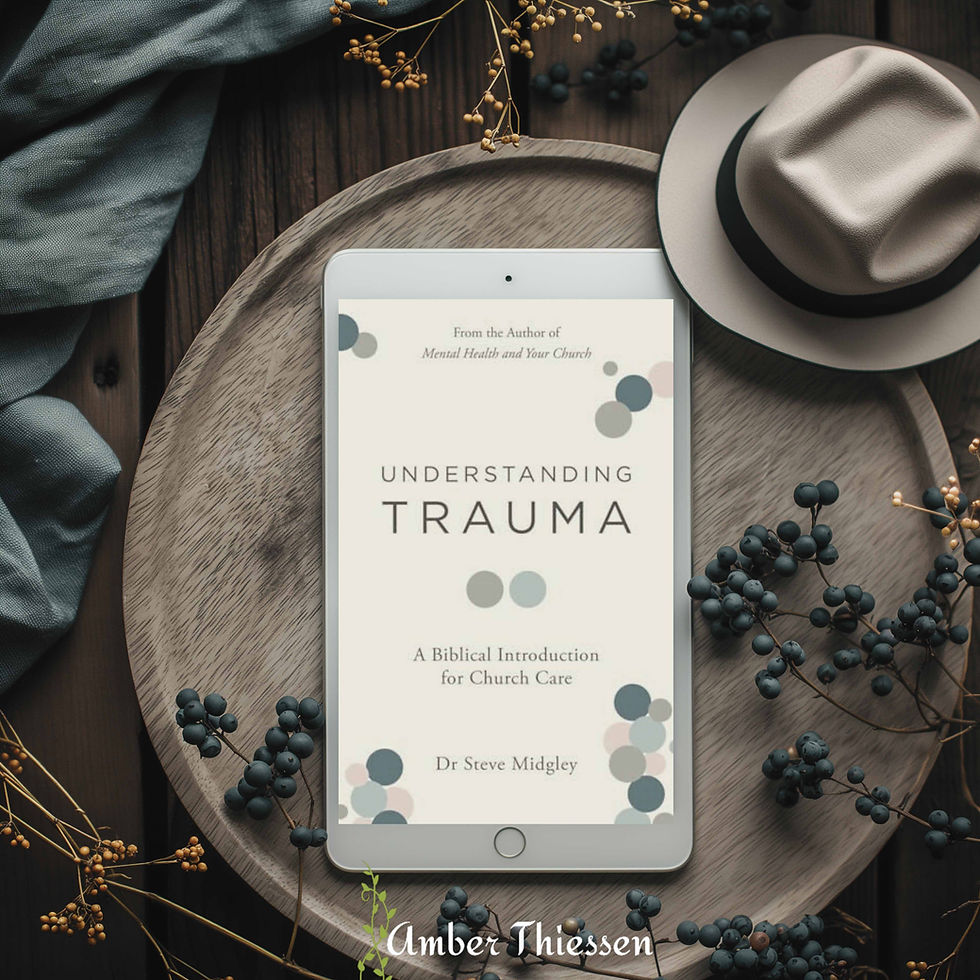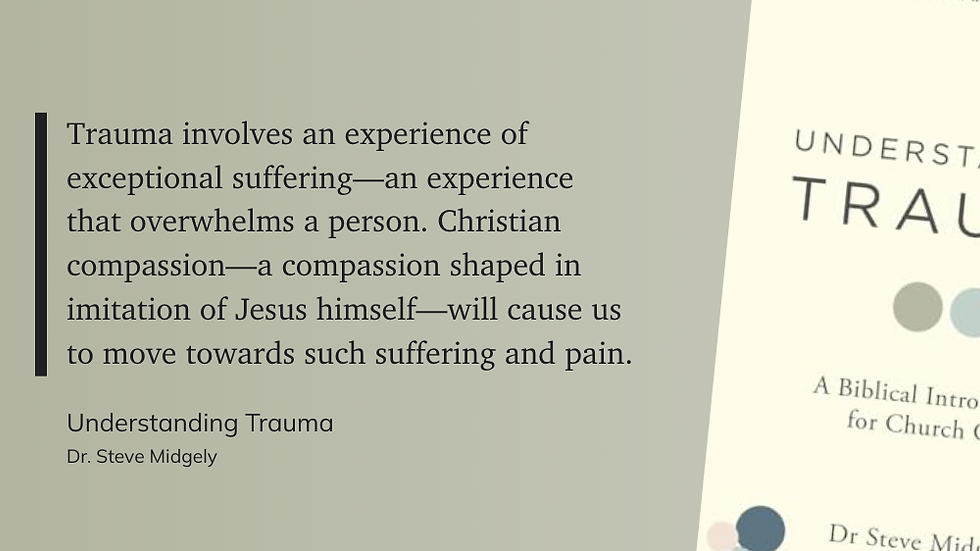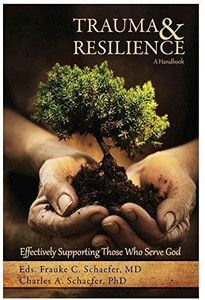Understanding Trauma: A Book Review and Personal Reflection
- Amber Thiessen
- Mar 26
- 5 min read

The language of trauma has become increasingly mainstream. In my own professional development in nursing, I’ve noticed a growing emphasis over the years on trauma-informed care, with workshops and discussions becoming more prevalent in workplaces. But as these conversations expand, the church has both an opportunity and a responsibility to deepen its understanding of trauma’s impact on the people in our communities and congregations.
After all, who better to love and serve those who are suffering than followers of a Savior who endured pain and grief — and now invites us to find hope and healing in Him?
Understanding Trauma: A Biblical Introduction for Church Care by Dr. Steve Midgley is an excellent primer for churches! He's served as both a psychiatrist and pastor, which gives him a lot of experience and insight to share with us.
Understanding Trauma: A Book Review and Personal Reflection
Content
Purpose of the Book
Table of Contents
Summary
My Take
My Recommendation
Quick Stats
More Like This
Scriptures About Care
Follow Along

Content
Purpose of the Book
Many in our churches are suffering, and as 'trauma' becomes an increasingly common cultural term, the church needs a clear and thoughtful introduction to the topic. Whether you're a ministry leader or a mentor, this book offers foundational insights to help you care for the hurting.
Table of Contents
Section One: Seeing Trauma in Scripture and Life
1. Trauma in the Bible
2. What is Trauma?
3. Encountering Trauma
4. Trauma and the Church
5. Jesus and Trauma
Section Two: Contemporary Thinking and Biblical Perspectives
6. How Trauma is Understood Today
7. Trauma and Memory
8. Trauma and the Body
9. Trauma and Relationships
Section Three: Responding with Compassion in the Local Church
10. A Thoughtful Welcome
11. Conversations About Trauma
12. Trauma and Lament
13. Trauma and Beauty
14. Trauma and the Hope of Jesus Christ
15. Churches That Care Well
Summary
In Section One, the author explores how we define and experience trauma, emphasizing that Scripture does not shy away from struggle or suffering. He also discusses how the church can avoid causing further harm and highlights the hope we have in our Savior, who both understands and transforms our trauma—now and for eternity.
Section Two presents an accessible overview of trauma’s symptoms and effects, the provisional nature of scientific theories in neuroscience, and the impact of trauma on relationships. The author also examines how the gospel shapes opportunities for reconnection and healing.
The final section remains deeply practical, outlining how the church can extend care through hospitality, meaningful conversations, and guiding the suffering in prayers of lament. He encourages believers to pour out truth, beauty, and hope into the brokenness of trauma, reflecting Christ’s redemptive work.

My Take: From Trauma to Healing
When our family lived in Africa, we experienced a home invasion involving weapons, physical harm, and threats against our children. The next morning, our neighbors gathered around us, offering comfort and helping us process what had happened. Their presence was a gift, but we still needed to leave our village for police reports and medical attention, driving to the city in the wake of the trauma.
In the aftermath, we lived on high alert, hypervigilant and constantly scanning for danger. Sleep was elusive, and my husband battled flashbacks and nightmares. The love and care of our friends and missionary colleagues acted as a soothing balm on the raw wounds of fear and pain. Our theology of suffering, shaped through our years on the field, grounded us — yet the symptoms persisted. I was in the early stages of our third pregnancy, and with concerns about miscarriage, we made the difficult decision to return to Canada a couple of weeks later.
Leaving a difficult situation doesn’t mean the challenges disappear. We knew that, yet we hadn’t anticipated how hard it would be to share our experience — with our leadership, our families, and our supporters. At first, we kept the details vague. How do you put the gravity of what happened into words without reliving it? And how do you avoid causing fear or panic in those half a world away?
Once we returned home, we realized just how much we had downplayed our experience. Many assumed we were simply back for the holidays. While it didn’t matter to us that everyone knew the full story, we deeply longed to be seen and understood by those closest to us — our friends, our pastors, and our church family.
After an initial meeting with our pastor, we gathered with our elders, pastors, and their wives in our home. We finally shared what had happened, and they responded with overwhelming kindness. Through their hugs, prayers, and words of Scripture, we were met with comfort and reassurance. They anointed us and prayed over us. In that moment, God’s peace surrounded us through the hands and hearts of those who shepherded us. By His grace, my husband never experienced another nightmare or flashback from that day forward.
We also engaged in trauma counseling, thoughtfully arranged by our mission. Through those sessions, we grew in self-understanding and gained the tools to process our memories. Step by step, we felt strengthened and equipped — ready to return.
That process became a story of its own — the opening chapter of what came next in our journey.
In sharing our experience, I hope to encourage you. Walking alongside those who suffer doesn’t require having experienced trauma yourself. What matters most is a willingness to sit, listen, and seek understanding. By gaining insight into common symptoms and struggles, you’ll be better equipped to offer support — always keeping the hope of the gospel in sight.

My Recommendation
An essential read for anyone in ministry today. Whether you're discipling moms, teenagers, or couples, having a basic understanding of trauma and its impact is crucial for truly understanding their experiences—and for speaking the gospel into their lives with wisdom and care. 5 stars!
Quick Stats
# of Pages: 208
Level of Difficulty: Easy-Moderate (some neuroscience, but explained in accessible terms)
My Rating: 5 stars
More Like This
Scriptures About Care
Let each of you look not only to his own interests, but also to the interests of others. (Phil. 2:4)
A new commandment I give to you, that you love one another: just as I have loved you, you also are to love one another. By this all people will know that you are my disciples, if you have love for one another.” (Jn. 13:34-35)
And let us not grow weary of doing good, for in due season we will reap, if we do not give up. So then, as we have opportunity, let us do good to everyone, and especially to those who are of the household of faith. (Gal. 6:9-10)
But if anyone has the world's goods and sees his brother in need, yet closes his heart against him, how does God's love abide in him? (1 Jn. 3:17)
Follow Along
Check out my profile on Goodreads
*A big thanks to the Good Book Company for the complimentary ecopy of this book and for the opportunity to post an honest review!









Wow, Amber, thank you for sharing your own story. ❤️ And thank you for this great review. I am looking forward to reading this, as it sounds like it will help me have a better understanding and empathy for those who have suffered trauma.
Great article, Amber 😊